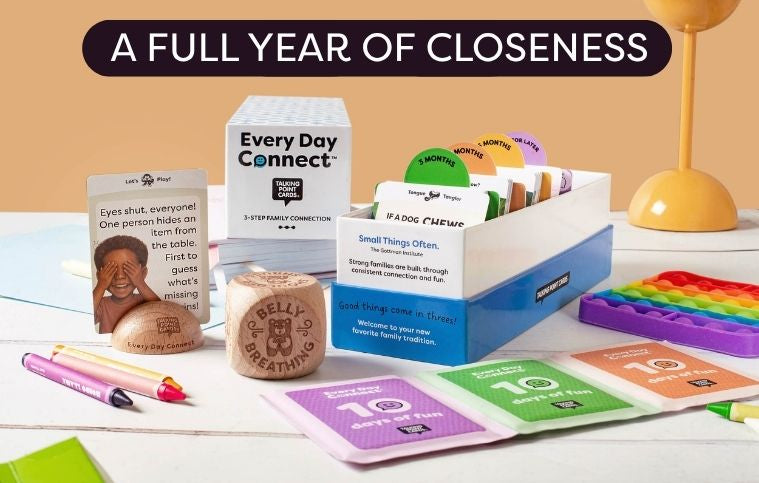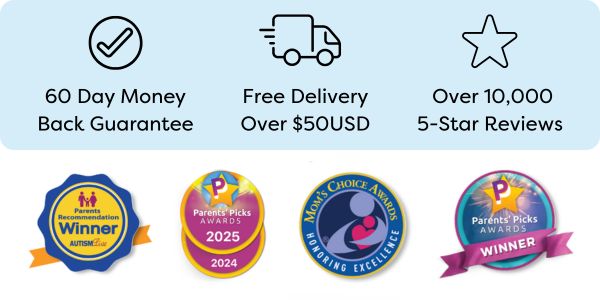SHOP
About
The Strategies
Making It All Work For Your Family
Shop Family Products
Look, I get it. You're sitting at the dinner table, trying to connect with your kid after a long day, and you throw out the usual "How was school?" only to get hit with a shoulder shrug and a mumbled "Fine."
Sound familiar?
If you're nodding along thinking yep, that's my Tuesday night, you're definitely not alone. Getting kids to open up—really open up—feels like cracking some kind of secret code sometimes. But here's the thing: parents everywhere are figuring out clever ways to bypass that whole awkward dance and actually get their kids talking.
And I mean really talking. Not just the surface-level stuff, but the good stuff. The thoughts, feelings, dreams, and yes, even the worries that are bouncing around in those beautiful little minds.
So I went digging to find out what's actually working for families right now. What I discovered? There are some seriously creative parents out there who've cracked the conversation code. Here are 10 approaches that are getting kids to drop their guard and share what's really going on.
1. The "Side-by-Side" Strategy
Here's something I learned that totally makes sense once you think about it: kids often open up more when you're not looking directly at them.
I know, I know. Eye contact is supposed to be this golden rule of good communication. But turns out, for a lot of kids (especially teens), direct eye contact can feel intense or intimidating when they're trying to share something vulnerable.
Parents are getting around this by having conversations while doing other things together. Folding laundry, washing dishes, working on a puzzle, or even just driving in the car. There's something about having your hands busy and your eyes focused elsewhere that makes the words flow easier.
One mom I talked to swears by car conversations. "Something about being in that enclosed space, both looking forward instead of at each other - my 14-year-old tells me everything during our drives to soccer practice."
2. The Power of the Written Word
Remember passing notes in middle school? Well, some parents are bringing that energy back in a really beautiful way.
Family journals are having a moment. Here's how it works: you keep a shared journal that gets passed between family members. Maybe it lives on the kitchen counter, maybe it travels from bedroom to bedroom. The idea is that anyone can write in it - thoughts, questions, observations, even little drawings.
What's magical about this approach is that it removes the pressure of immediate response. Your shy kid can process their thoughts, write them down when they feel ready, and know that you'll read and respond thoughtfully.
Plus, there's something about writing that helps kids (and adults, honestly) access thoughts and feelings they might not be able to express out loud right away.
3. Conversation Cards That Actually Work
Okay, this one's been a game-changer for so many families I've talked to. Talking Point Cards Family Edition contains 200 straightforward questions and topics that children and parents alike will love sharing together, and they're specifically designed to move beyond those dreaded one-word answers.
Here's why these work so well: they take the pressure off you to come up with interesting questions on the spot (because let's be real, after a long day, "How was school?" is about all our brains can muster). But more importantly, they give kids permission to share things they might not bring up otherwise.
The more children (and adults) interact with interesting and novel questions in a safe environment, the better they get at thinking on their feet and expressing themselves.
I love that these aren't your typical "What's your favorite color?" kind of questions either. They dig a little deeper without being too heavy. Questions like "What's something you used to believe that you don't believe anymore?" or "If you could have dinner with anyone, living or dead, who would it be and why?"
The beauty is in how they spark natural follow-up conversations. One question leads to another story, which leads to another question, and before you know it, you're having the kind of conversation you've been hoping for.
4. The "Walk and Talk" Method
There's something almost magical about walking together. Maybe it's the rhythm of putting one foot in front of the other, or maybe it's just that you're literally moving forward together, but kids seem to open up more when they're walking.
Some families have made this a regular thing - evening walks around the neighborhood, weekend hikes, or even just walking to the mailbox and back. The key is keeping it low-pressure. You're not walking to have a conversation; you're just walking together, and conversation happens naturally.
"My 10-year-old tells me the most random, wonderful things when we're walking our dog," one dad shared. "Just last week, she told me about a dream she had, her thoughts on why adults seem stressed all the time, and her plan to start a business selling painted rocks. None of that would have come up at the dinner table."
5. Question Jars and Family Games
This one's particularly genius for families with multiple kids. You create a jar (or box, or whatever) filled with conversation-starting questions. During dinner, car rides, or just random moments when everyone's together, someone pulls a question and everyone takes turns answering.
What I love about this approach is that it becomes a family tradition rather than something that feels forced or therapeutic. Kids often get excited about whose turn it is to pick the question, and there's something about the randomness that keeps things interesting.
Plus, when everyone's answering the same question, kids get to hear how their parents and siblings think too. It becomes less about being put on the spot and more about sharing together as a family.

Rated #1 Family Product
Strengthen family bonds, spark fun and meaningful conversations, and create connection that lasts.

6. The Art of Timing (It's Everything)
This isn't so much a strategy as it is an awareness that smart parents are developing: timing matters so much when it comes to getting kids to open up.
The after-school rush? Probably not the best time for deep conversation. Right before bed when everyone's tired? Also maybe not ideal (unless your kid happens to be one of those who gets chatty when they're sleepy - some do!).
Parents who are having success with conversations are paying attention to when their kids naturally seem more open. For some kids, it's first thing in the morning when the world feels quiet. For others, it's that sweet spot after dinner but before homework stress kicks in.
One mom noticed her teenager was most talkative while baking together on Sunday afternoons. "I don't know what it is about measuring flour and mixing batter, but that's when she tells me about friend drama, school stress, all of it."
7. Creating "Sacred" Conversation Spaces
Some families are getting really intentional about creating specific times and places that are just for conversation. No phones, no distractions, just talking.
This might look like a weekly breakfast date with just one parent and one kid. Or maybe it's a designated "talking time" every Tuesday night where everyone gathers in the living room and just shares what's on their mind.
The key is making it regular and predictable, so kids know it's coming and can mentally prepare. And it has to feel special, not like a chore or obligation. One family I know calls it their "connection hour" and everyone actually looks forward to it.
8. Following Their Lead and Interests
Here's something that seems obvious but is surprisingly easy to forget: kids are way more likely to talk about things they're actually interested in.
Instead of always steering conversations toward what you think is important (grades, chores, behavior), savvy parents are learning to follow their kids' lead. If your 8-year-old is obsessed with dinosaurs, start there. If your teenager can't stop talking about a particular YouTube channel, lean into that.
The beautiful thing about this approach is that when kids feel heard and validated about the things they care about, they're more likely to trust you with the bigger, more important stuff too.
9. The Power of Shared Activities
Remember how some of your best conversations with friends happen when you're doing something together rather than just sitting and talking? The same principle applies with kids.
Families are finding that conversations flow more naturally when hands are busy. Cooking together, building something, working on art projects, playing board games - these activities create a natural backdrop for conversation without the pressure.
"My son and I build model airplanes together," one dad told me. "While we're focused on gluing tiny pieces and painting details, he tells me things I never would have heard otherwise. There's something about having something else to focus on that makes the talking feel easier."
10. Being Genuinely Curious (Not Just Checking Boxes)
This last one might be the most important: kids can tell when you're asking questions because you feel like you should versus when you're asking because you genuinely want to know.
The difference between "How was your day?" (checking the parenting box) and "What was the most interesting thing that happened today?" (genuine curiosity) is huge. Kids pick up on that energy immediately.
The most successful conversations happen when parents approach their kids with real curiosity about who they are as people, not just how they're performing as students or family members.
Making It All Work for Your Family
Here's the thing about all these strategies: not every single one will work for every family. Kids are different, parents are different, family dynamics are different. The magic is in trying different approaches and seeing what clicks for your unique situation.
Maybe your family becomes the car conversation family. Maybe you're the walking family, or the cooking family, or the conversation cards family. Maybe you're a combination of several approaches.
The important thing is that you're being intentional about creating opportunities for real connection. Because in a world full of screens and busy schedules and endless distractions, these moments of genuine conversation with our kids are becoming more precious—and more necessary - than ever.
And honestly? The effort is so worth it. When your kid starts sharing their real thoughts, dreams, worries, and ideas with you, when they trust you enough to let you into their inner world, it's pretty much the best thing ever.
Those connections you're building now? They're laying the foundation for a relationship that will last their whole lifetime. And that's something worth working for, don't you think?
Looking for conversation starters that actually work? The Talking Point Cards Family Edition has helped thousands of families move beyond "How was your day?" and into real, meaningful conversations. With 200 thoughtfully crafted questions designed for all ages, they're the perfect tool to help your family connect on a deeper level.
----------
Looking for conversation starters that actually work? The Talking Point Cards Family Edition has helped thousands of families move beyond "How was your day?" and into real, meaningful conversations. With 200 thoughtfully crafted questions designed for all ages, they're the perfect tool to help your family connect on a deeper level.
At Talking Point Cards, we believe that meaningful connection starts with simple, heartfelt conversations. Our collection of easy-to-use, engaging conversation starters helps families of all shapes and sizes put down their screens, lean in, and truly listen to one another - one question at a time. Because stronger families aren’t built in grand gestures - they’re built in everyday moments.
Let's Stay Connected
Love what you’re reading? There’s more where that came from. Get fresh ideas, inspiring tips, and simple ways to spark deeper conversations - delivered straight to your inbox. Because the best connections start here. Just pop in your email below to join us.
We respect your privacy. We’ll never share or sell your information. By subscribing, you agree to receive emails from us. Unsubscribe anytime.












